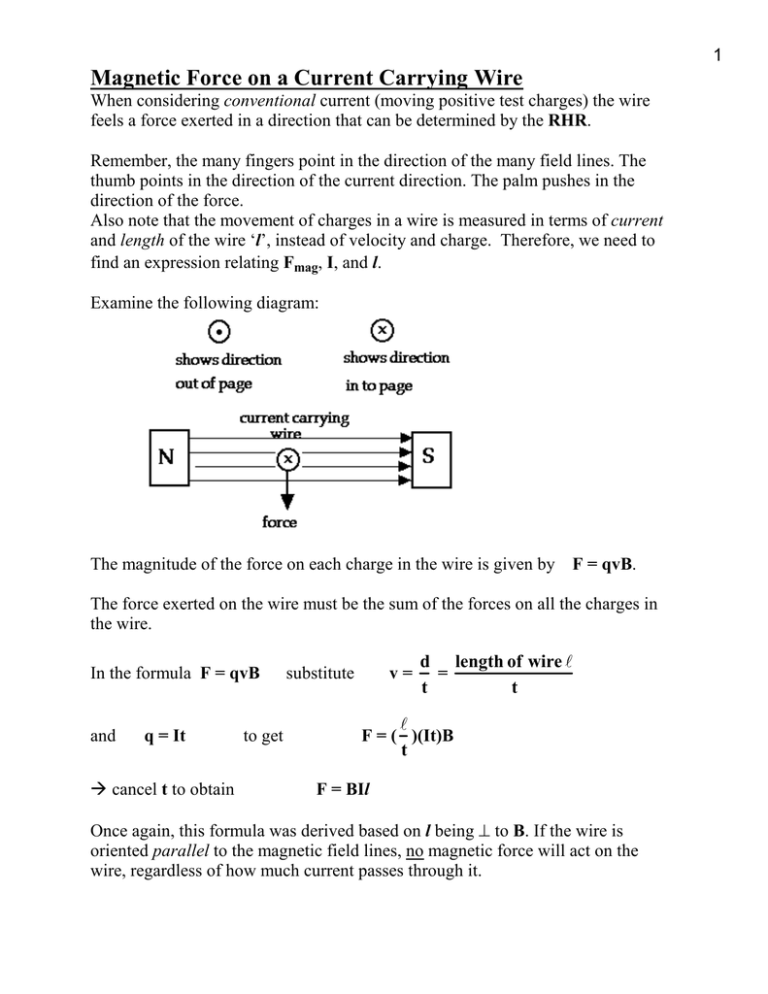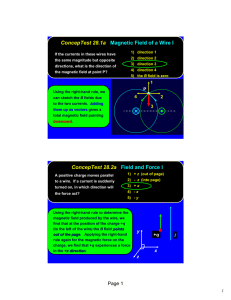Current Carrying Wires and Magnetism Notes
advertisement

1 Magnetic Force on a Current Carrying Wire When considering conventional current (moving positive test charges) the wire feels a force exerted in a direction that can be determined by the RHR. Remember, the many fingers point in the direction of the many field lines. The thumb points in the direction of the current direction. The palm pushes in the direction of the force. Also note that the movement of charges in a wire is measured in terms of current and length of the wire ‘l’, instead of velocity and charge. Therefore, we need to find an expression relating Fmag, I, and l. Examine the following diagram: The magnitude of the force on each charge in the wire is given by F = qvB. The force exerted on the wire must be the sum of the forces on all the charges in the wire. In the formula F = qvB and q = It cancel t to obtain to get substitute v= d length of wire l = t t l F = ( )(It)B t F = BIl Once again, this formula was derived based on l being ⊥ to B. If the wire is oriented parallel to the magnetic field lines, no magnetic force will act on the wire, regardless of how much current passes through it. 2 Example # 8: The magnetic field strength inside a solenoid is 0.025 T. If a 3.2-cm long conducting strip positioned at right angles to the magnetic field -4 inside the solenoid experiences a force of 5.9 x 10 N, what is the current in the conducting strip? (see Electromagnetism Ex 8 for answer) Aside: Similar to before, in college physics, you will learn that when a wire placed at an angle in the field, use the perpendicular component of the field to the wire direction so that F = BIl sinø Magnetic Force Between Two Long Parallel Conductors Suppose there are two parallel wires placed in close proximity to each other, each with current flowing in the opposite direction. Each wire, producing its own magnetic field, exerts a magnetic force on the other. Examine the following diagram: I1 I2 To determine the magnetic force exerted on I2 by I1: first determine the magnetic field B produced by using the RHR for current I1 3 magnetic field is out-of-page on left side of I1 magnetic field is into-page on right side of I1 B due to I1 next, use the RHR for mag. force to determine the direction of the force acting on I2; draw this force direction above and describe it I2 • • • I1 • • • • • x x x x • • • • x x x x x x x x Fmag pushes I2 to the right • • • • x x x x • • • • x x x x magnetic field due to current I1 Similarly, I2 produces a magnetic field that in turn causes a magnetic force to push I1 to the left (you can prove this yourself). In other words, two parallel wires carrying current in opposite directions repel each other. Example # 9: Prove, using both types of the RHR, that two parallel wires carrying current in the same direction are attracted to each other. (see Electromagnetism Ex 9 for answer)




